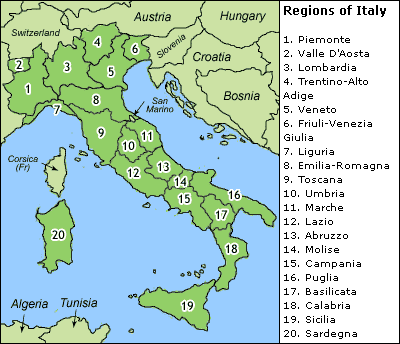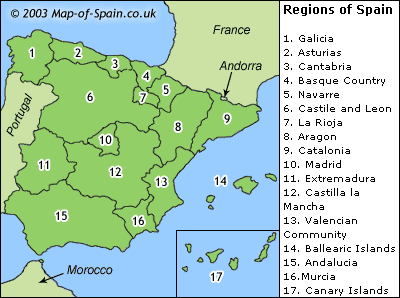
of the Renaissance
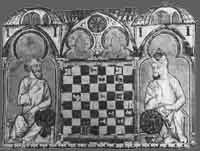
prologue
In almost poetic symmetry,
the Renaissance - the resurgence of interest in forgotten classical culture that generated an unprecedented interest and growth in science, music and art - coincided with what can only be considered a rebirth of Chess. The spark that lit the fire under both the Renaissance and chess was the invention of the commercial printing press around 1450. Just as the new availability of books brought literature, science and philosophy to the average man, they also helped solidify, codify and make uniform the changes that signified the metamorphosis of chess from the slow, plodding, medieval proto-chess into its dynamic, modern form.
Just as the Common Man himself had changed - adapting to a new roles brought about by a depleted population, a redistribution of wealth, new social structures, better education and all the self-awareness that comes with it - so did the Chess Men. Once regarded as either tools for military training or as actors in in some allegorical morality play, the chessmen of Mad Queen Chess (Scacchi all rabiosa by the Italians and Echecs de la dame enragee by the French), as the modern chess form was often called, gained their own sense of worth - in keeping with the Renaissance's philosophy of Humanism. With such drastic changes in the game, any strategies conceived up to this point (most people consider this point to be around 1475 when the earliest recorded modern chess game can be found in the Valencian poem, Eschacs d’amor) became practically worthless and chess became a virtual tabula rasa, a clean slate as well as a new frontier as open for discovery as would be the New World in less than 20 years.
Invading Muslims carried the game of chess to Europe .Some chess historians claim that the same Castilian warrior queen, Isabel, coronated in 1472, who financed Columbus' famous voyages, was the model for the newly created chess queen the revolutionized the game. Under the rule of Isabel of Castile and Ferdinand of Aragon, Spain united and reached its greatest glory - but experienced one of its most criticized events, the Inquisition. In one of the perversities of history, the youngest daughter of Isabel, who is referred to as the Catholic Queen was Catherine of Aragon. Catherine married Arthur, the Crown Prince of England and after his death, married his brother, Henry VIII. Henry was to renounce the Catholic Church's authority in England and establish his own Church of England with himself as the head, for the express purpose of ridding himself of Catherine so he could marry one of her ladies, Anne Boleyn.
Since the Muslims conquered most of Spain, that area became the original seedbed of chess culture. But the Muslims also conquered Sardinia and Sicily and the game of chess became popular in the areas which is now make up Italy. The Muslims were eventually driven from Spain and the Italian cities started flourishing, establishing their own culture. The rules and customs of chess varied greatly from place to place, and though the printing press helped to codify certain changes, these changes weren't immediately universal. But there was no doubt about the popularity of the new Queen, the empowered Bishop, the new two-move option for pawns and, later, castling and queening of pawns. But it was a long process to enact these changes. But the changes were nonetheless inevitable.
It's ironic that chess blossomed under deeply religious cultures: first proto-chess within the Islamic culture, then modern chess within the Christian culture. The irony lies in the fact that both these religions alternately condemned and encouraged the game. And further irony lies in the observation that in the Christian culture, the clergy were the main proponents of the game. Interest in the game passed on to the nobility and chess became the Game of Kings.
Because proto-chess was so painfully slow, baring the king, that is, capturing all the enemy's men save the King, was a win. That same lethargic style made books on strategy seem someone unimportant, relegating most medieval chess texts to poems, love stories, allegories, apologies and problems. But modern chess proved to be more tactical, and therefore more strategical (as all tactics flow from good positions). As such, the books on modern chess started in imitation of medieval texts, but gradually started dealing with the complexities and dynamics of the newer game.
The actual playing strength of the early masters of the game whom we know about is hard, if not impossible, to determine. We have to assume they we the crème de la crème of their day, but for the most part too few games are extant. It's also easy to assume they didn't know much about chess, but one must consider that:
1. for many chess was their stock and trade and they kept their secrets well guarded. We know what they've written, but that doesn't mean we know what they knew.
2. What we take for granted today are ideas that didn't exist at the time. These players, through hard work and trial and error, invented, created and developed their chess almost totally unassisted. They had no databases, no master games, no opening books and far fewer chances to employ their ideas against a variety of opponents. When you consider that most chess isn't so much creation as it is re-creation - and even what we might call creation today is usually the application of things we've learned to new situations - and that these players had few such memories or experiences to draw from, it's hard to consider their playing weak in any sense of the word without indicting one's own lack of insight.
It should be noted that the following information concerning early chess players may not be everything than is known about them but it is everything I could uncover with available resources. Some of what has been written is legend and not necessarily fact and often I have found contradictions. I'll try to present the facts as facts and the legends as such in all their various forms. If anyone has information or corrections, I would always appreciate learning about it.
the players
The first players of modern chess that we meet are three Catalan poets from Valencia, Spain.
Francí de Castellví, Narcís Vinyoles and Bernat Fenollar were members of the avant-guard literary culture of the exciting seaport city of Valencia. They wrote the classically inspired love poem, Eschacs d’amor, pitting gods and goddesses against each other in a game of (modern) chess.
The also collaborated of other minor poems. According to Dr. Ricardo Calvo, Francí de Castellví, the winner of the first (though manufactured) modern game ever recorded, "...was lord of several towns in the area around Jativa. He acted as a close adviser in the Aragonese court of King Ferdinand. He was surely a member of a distinguished Valencian family." Castellví died on November 6, 1506 giving a positive limit to when the poem could have been written. Narcís Vinyoles was born around 1445 and died in 1517. He was a lawyer, judge and politician as well as a prolific poet. He had a childless marriage to a much younger woman, Brianda, the niece of a rich, influential banker, Luis de Santangel (who, coincidentally, financed Columbus). He spoke Catalan, Castilian, Latin and Italian and was possibly acquainted with Juan de Lucena. Bernat Fenollar was a clergyman, born around 1435 and died in 1527. He came from an influential family Valencian from the town of Penaguila in Alicante province. While he dabbled in the arts, he was mainly a patron and advocate of artists. He was probably the hub of the literary/chess circle in Valencia around this time. He was instrumental in getting the first Valencian book printed (in which all three of these men were included). He had a position at the cathedral of Valencia and eventually became a professor of mathematics at the university. He was very well off financially and more than likely was also acquainted with Lucena.
Luis Ramirez Lucena, author of Repeticion de amores e arte de axedrez con CL juegos de partido, a book containing 10 opening and 150 positions, illustrated with 160 woodcuts, from both old and modern chess. The book was dedicated to the son of King Ferdinand, Prince Don Juan who died in 1497. The newly created queen, la dama, is featured prominently in this 1497 book. Lucena was at least part Jewish and as such, he was affected by the Spanish Inquisition the purpose of which was to strengthen the state by purging itself of possible enemies - that is, Muslims and Jews - by conversion, expulsion or death. Jews who converted were called conversos, This class was never fully trusted nor never fully accepted, but its members were tolerated and put to good use. (it should be noted here that hundreds of thousands of Jews and Muslims were expelled from Spain by 1492. Since chess was most popular within these two cultures, such a mass migration hastened the spread of chess throughout Europe) This was Lucena's class. Lucena lived from 1465 until 1530 and, although he was likely born in Aragon, was still a student in Salamanca when he wrote his book. It's likely that Lucena also wrote the Gottingen Manuscript, an undated, 33 page quarto parchment manuscript written in Latin offering twelve openings and thirty chess problems with solutions as well as the Paris Manuscript, written in French, in the early 16th century. His father, Juan de Lucena, had been an ambassador of King Ferdinand of Aragon, and it's recorded that young Luis traveled with him to Italy and France, most likely via Valencia, where he was likely exposed to their type of chess. But when the Inquisition began, his family, once prominent, took a turn for the worse. His brother was imprisoned and the family was harassed by the Inquisitor General of that province, so much so that Juan complaint to the King himself.
 Girolamus Cardanus was a medical doctor, an astrologist, a mathematician and an inventor who live from 1501 to 1576. He was a chess addict and among his 249 written works, wrote a book on chess. Unfortunately the book hasn't survived. But in the process of publishing the book, he solved the problem of how to represent the black piece on top of the black squares. Rather than using solid black to represent the black squared, he discovered that shaded squares, using thin horizontal lines, allowed the black piece to be seen plainly. Also in his writings he obliquely refers to the book, also lost except for the front page, of Francesch Vicent, indicating it's poor representation of diagrams (at least 100) as well as it's popularity it Italy - which in turns suggests that it was at least partly comprised of modern chess problems.
Girolamus Cardanus was a medical doctor, an astrologist, a mathematician and an inventor who live from 1501 to 1576. He was a chess addict and among his 249 written works, wrote a book on chess. Unfortunately the book hasn't survived. But in the process of publishing the book, he solved the problem of how to represent the black piece on top of the black squares. Rather than using solid black to represent the black squared, he discovered that shaded squares, using thin horizontal lines, allowed the black piece to be seen plainly. Also in his writings he obliquely refers to the book, also lost except for the front page, of Francesch Vicent, indicating it's poor representation of diagrams (at least 100) as well as it's popularity it Italy - which in turns suggests that it was at least partly comprised of modern chess problems. In 1512, not long after Lucena had his book published, another chess player named Pedro Damiano also published a book. Damiano came from Odemira in south-west Portugal and was an apothecary (a pharmacist) by trade. His book, Questo Libro e da imparare giocave a scachi, consisted mostly of problems - all but one of which he copied from other sources - and was the first chess book published in Italy and the first book to offer no mention of medieval chess. It was written in both Spanish and Italian. He delved into a few openings and gave some practical advice. He also reasoned that the Spanish name for chess, Axedrez, came from Xerxes who invented the game. His book was on the best-seller list for 50 years, re-published 8 times in Italy alone and translated into English, French and German. Damiano who was born in 1500, died at age 44.
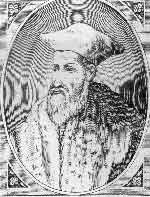
Marcus Hieronymus Vida was born in Cremona in 1490 and died in Alba in 1566. In 1510 he moved to Rome and became a priest. By 1519, he was elevated to prefect of San Silvestro in Monte Corno, a town near Frascati by Pope Leo X and in 1532 became the Bishop of Alba. He began writing his famous poem called alternately De Ludo Scaccorum and Scacchia Ludus in 1507, finishing it around 1513. He published it anonymously in 1525 and again, this time with his name and picture in 1527. In the poem the Roman god Apollo plays Mercury in a game of chess. Vida describes the rules of the game and the pieces used in great detail. Instead of Bishops, Vida employs the term, Sagittifer or Archers; instead of Rooks, he uses Elephas or Elephant. The poem concludes with Mercury's victory after which he seduces a nymph named Scacchis and compensates her by teaching her this godly game and naming it after her.
Then next five players are mentioned in the context that their lives intersected at the first great chess congress where Ruy Lopez de Segura and Alfonso Ceron represented Spain while Leonardo di Cutri (also called Leonardo di Bona) and Paolo Boi, accompanied by Giulio Cesare Polerio, represented Italy.
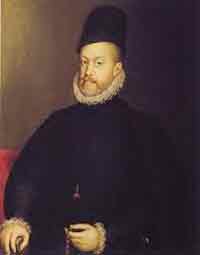
This portrait was by Sofonisba Anguissola, one of the few great women painters of the Renaissance. To see her famous Chess painting and short biography, click her name.
In 1575 there was a chess match at the court of Philip II, King of Spain, in Madrid. Philip's father, Charles V, was the son of Juana the Mad or Crazy Joanna, Queen of Castile, the daughter of Ferdinand and Isabel and of Philip the Handsome, the son of Holy Roman Emperor Maximillian I. Charles V proved to be one of the greatest of the Hapsburg Emperors. But he abdicated his throne and In 1554 he gave Naples and Milan to his son Philip, in 1555 he turned over the Netherlands to Philip and in 1556 he made him king of Spain and Sicily as Philip II.
During the height of the Renaissance, the land which is now Italy was comprised mostly of city-states ruled by powerful families such as the Visconti, the Sforzam the Este and the Medici, but by 1550 almost all Italy had been subjugated by Charles V and became part of the Hapsburg Empire. Philip inherited all this, as well as Spain. So, it can be seen that in 1575, Spain and Italy were virtually the same country, though far apart and very different.
It's often portrayed that Ruy Lopez and Alfonso Ceron were Spanish players, while Boi and Leonard were foreign competitor to whom Philip begrudgingly gave the prize. This is true to a certain extent, but it must be considered that Ceron was from Granada, also a Hapsburg territory; Ruy Lopez was from Southern Spain; Boi was from Siracusa; Leonardo were from Calabria: they were all subjects of Philip II. Italy would be controlled in some way by Spain for more than 100 more years.
Philip II was considered an ineffectual monarch. According to one site: ...he was cold, suspicious, secretive, scrupulous to excess, indecisive and procrastinating, little disposed to clemency or forgetfulness of wrongs. In 1588, Philip's single-mindedness led to the destruction of the Spanish Armada which diminished Spain's influence considerably and permanently.
Some have written that Ruy Lopez went to Spain to obtain a chess book for Philip II and, after happening on Damiano's book, considered it lacking and decided to write his own. Other's have written that Ruy Lopez went to Rome on ecclesiastical business and
one seemingly well researched site states that he went to Rome for the coronation of Pope Pius IV, (who had been pontificated in 1559, the year previous). Salvio tells us that Ruy Lopez went to Rome in 1572 to attend the pontification of Pope Gregory XIII and while there, defeated many of Rome's best players. Of course, this was long after he had written his famous book, Libro de la Invencion Liberal y Arte del Juego del Axedrez, in 1561. So, it seems likely that Ruy Lopez went to Rome, for whatever reason, in 1560 and again in 1572
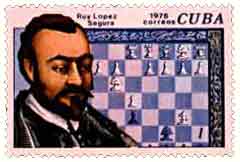 - where, according to Salvio he beat Leonardo, playing for 50 scudi/game.
- where, according to Salvio he beat Leonardo, playing for 50 scudi/game.Scudo \Scu"do\, n.; pl. Scudi.
[It., a crown, a dollar, a shield, fr. L. scutum a shield. Cf. Scute.] (Com.)
(a) A silver coin, and money of account, used in Italy and Sicily,
varying in value, in different parts, but worth about 4 shillings,
sterling, or about 96 cents; also, a gold coin worth about the same.
(b) A gold coin of Rome, worth 64 shillings 11 pence sterling, or about $ 15.70.
Source: Webster's Revised Unabridged Dictionary, © 1996, 1998 MICRA, Inc.
He published his book in 1561 in Alcala de Henares. Since it takes longer than a year to travel to Rome and back from southern Spain, plus to write and publish an analytical book, it seems unlikely that Ruy Lopez only just discovered Damiano's work on his trip in 1560, but that, having access to the great Spanish libraries, he already knew what chess literature was available. It's said that he made a fortune on the book he wrote. It's very possible, but, while it does seem inconsistent with the nature of his occupation, it's not so inconsistent with the playing for stakes.
While in Rome in 1560, Ruy Lopez met with and defeated Giovanni Leonardo di Bona from the town of Cutro in Calabria, who was considered the strongest of the Italian players. Either he beat him at two games at this time, or one in 1560 and again in 1572, but it seems the consensus that Ruy Lopez had beaten Il Puttino at two games total. Someone wrote that Ruy Lopez managed a blindfold game in 1560.
Ruy Lopez dies around 1580 at the age of 50.
Little more is written about Ruy Lopez until 1575 when Leonardo di Cutri and Paolo Boi, along with Giulio Cesare Polerio, visited the court of Philip II in Madrid and a match was set up pitting Ruy Lopez and Leonardo di Bona.
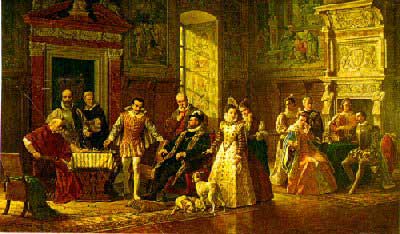
From left to right:
Ruy Lopez (sitting), the Duke of Lorena, Fra Diego de Chaues-the King's Dominican confessor, Leonardo di Bona, Don Cristoforo de Mora, Philip II (sitting), L'Infante Isabella Clara Eugenia-daughter of Philip II, her handmaiden, lady-in-waiting of the Queen, Queen Anna Maria von Oesterreich the daughter of Emperor Maximilan and third wife of Philip II (sitting), the Duchess of Lerma, major domo of palace, a page, Don Giovanno of Austria-victor of the Battle of Lepanto(sitting)
In his book, Il Puttino, altramente detto, il cavaliero errante, sopra il gioco de' scacchi, Salvio wrote that Leonardo lost his first two games, and when King Philip was leaving, thinking this wasn't going to be much of a competition, Leonardo begged him to stay and told that him he lost those 2 games on purpose to better display his skill by positioning himself where he had no option but to win the next 3 games (and presumably the match) and, that if he didn't win all three, he'd forfeit his life. Philip II had offered 1,000 scudi bonus to the winner of three consecutive games. He won all three games in a fitting revenge for what he considered a humiliating defeat at Ruy Lopez's hands years before. Philip II was so taken by Leonardo's courage and panache that he not only gave him the money, but also a golden salamader encrusted with jewels, a sable coat and exempted the town of Cutro from taxes for 20 years.
Paolo Boi had also traveled to Madrid at this same time and showed up for the match. Giulio Cesare Polerio, Leonardo's protégée and follower was there too, though it's doubtful that he played. Since Alfonso Ceron, a player from Granada and reputably the second best player in Spain, was also at the court, some offhand games took place. Presumably, Boi and Leonardo established their complete dominance over Ruy Lopez and Ceron. The Italians dominated chess from that point until the appearance of Francois-Andre Danican Philidor in the middle of the 18th century.
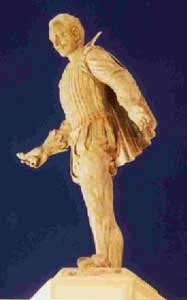 Leonardo di Bona was also known as Leonardo di Cutri and il Puttino - this translates as the Boy, which could possibly carry the idea of the Kid, as in Billy the Kid, which would give him a sort of a rascally connotation, except puttino also seems to mean cupid, which would give him a sort of sweet, angelic connotation; at any rate he was il Puttino because of his small stature and because the Italians back then apparently loved nicknames - and as Cavaliere Errante by King Sebastian of Portugal (who, it should be noted, was very young - he was born in 1557 and died in a expedition against Morocco in 1578 - in 1580, Philip II of Spain took over Portugal as Philip I of Portugal).
Leonardo di Bona was also known as Leonardo di Cutri and il Puttino - this translates as the Boy, which could possibly carry the idea of the Kid, as in Billy the Kid, which would give him a sort of a rascally connotation, except puttino also seems to mean cupid, which would give him a sort of sweet, angelic connotation; at any rate he was il Puttino because of his small stature and because the Italians back then apparently loved nicknames - and as Cavaliere Errante by King Sebastian of Portugal (who, it should be noted, was very young - he was born in 1557 and died in a expedition against Morocco in 1578 - in 1580, Philip II of Spain took over Portugal as Philip I of Portugal). He was born in 1542 (some sources claim he was born in 1552, but since he played against Ruy Lopez in Rome, as a law student, in 1560, this seems highly unlikely) in the town of Cutro in the Province of Crotone in region of Calabria.
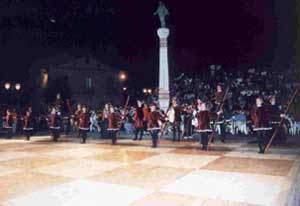
This is la Piazza Leonardo di Bona in Cutro. A giant chessboard is part of the architecture. Each year there is a tournament held there, named of Leonardo di Bona, as well as a live chess game performed in 16th century period costumes.
(The picture of il Puttino on the right is a close-up of the statue on the column in the picture on the left.)
Leonardo was a law student, studying in Rome, when Ruy Lopez first played him. He was accustomed to winning and took his defeat by Ruy Lopez very seriously. After the loss, he went to Naples and studied the game with his uncle (some say with Paolo Boi at the palace of Boi's benefactor, Prince Fabrizio Gesualdo of Venosa where Boi had a chess academy - at any rate Boi lived in Naples at that time and was much older, more famous and more experienced than Leonardo, so it's very possible that they trained together. It's also indicated that at this time they were comparatively equal in strength.) after which his game improved remarkably.
The most rational scenario seems to be that Ruy Lopez came to Rome in 1560 and established a reputation as a player by beating all comers. However, if Leonardo di Bona was born in 1552, he wasn't one of them. If he was born in 1542, then he was only 18. When Ruy Lopez returned to Rome around 1572-73, he played and beat Leonardo, who learned the game in Rome and seemed to have some natural talent, in 2 games. Leonardo retired to Naples at the palace of Prince Fabrizio Gesualdo who was Paolo Boi's benefactor and where Boi conducted a chess academy. There he improved his game over the next two years and became, at the very least, Boi's equal. Somewhere in this time Leonardo supposedly played against a Turkish or Saracen pirate captain for the release of his brother whom they held prisoner. Not only did he win his brother's freedom, but he took some prizes in addition. Confident again in his abilities, Leonardo, accompanied by Polerio, went to Genoa to sail for Madrid for the express purpose of challenging Ruy Lopez. There he met a woman, fell in love and proposed before leaving. He arrived in Madrid and challenged Ruy Lopez at 50 scudi per game, winning all the games. Philip II heard of this and invited Leonardo to play Ruy Lopez is a sort of official match, for prizes as well as fame, at his court. Alphoso Ceron, a Portuguese player considered 2nd only to Ruy Lopez, was present as well as Leonardo's student, Polerio, and Paolo Boi who arrived according to his own famously spirited manner. Leonardo lost the first two games and Philip II, thinking he overestimated the Italian player, made to leave. But Leonardo begged him to stay, explaining how his play was a set up for a dramatic finale. He convinced Philip II and the match continued with Leonardo easily beating Ruy Lopez the next 3 games straight. For winning 3 straight games, Leonardo received 1000 scudi. For winning the match, he received a jewel-encrusted brooch in the shape of a salamander, a sable fur and, after some negotiation, his home town of Cutro was given a reprieve from taxes for the next 20 years. After the match, Leonardo received news that his fiancée had died. Rather than returning home, he decided to travel. He went to Portugal where he defeated King Sebastian's house player, il Moro or the Moor. He met up with Boi there in Lisbon and beat him in a match. Leonardo returned to Italy during the early 1580's. First to Genoa and Taranto, accompanied by his student, Giulio Cesar Polerio, and then to Naples where he once again played against Paolo Boi - this time before his patron, Don Pedro Giron, duke of Ossuna, viceroy of Naples (who commissioned the National Archaeological Museum in Naples, preserving the artifacts from Vesuvian interred Pompei). The match was considered a draw. Leonardo di Bono was poisoned in 1587 (some say 1598) at the age of 45.
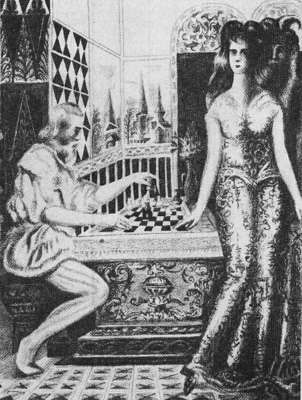 Paolo Boi, also known as il Bove or il Siracusano, was born in Syracuse, Sicily in 1528 to a well-to-do family. Although he was a promising student, Boi took an early infatuation with chess which soon became his
obsession. He soon became the best player in Sicily, defeating his closest three challengers simultaneously and blindfolded. Boi was described by Don Peter Carrera, who met him when Boi was 70, as a large man (hence his nickname il Bove, the Ox) but well-proportioned and handsome. He was as fond of traveling as he was of chess and was in the habit of taking impromptu, unannounced trips, staying gone for a long time much to the consternation of his family. His fame as a chess player became such that he was sought out by patrons. Even Catherine de' Medici of France and Pope Paul III (who created the Jesuit order in 1540) were
enamored with Boi. While he played and defeated the pope in 1549, he never had the chance to do the same to the queen of France. Boi set up an academy at the palace of Prince Fabrizio Gesualdo of Venosa where he earned 300 scudi/year. There he met and played Leonardo di Bono in a match for the first time, surprisingly to a draw. Boi was known as an very fast player while Leonardo was much slower and somewhat more accurate. They retained a friendly,
healthy competitiveness throughout their lives. In 1575 Boi traveled to Madrid, apparently aware of Leonardo's intention to challenge the Spanish players, particularly il Vescovo di Segura, Ruy Lopez. Both Leonardo and Boi succeeded in besting their opponents at the court of Phillip II. Although Leonardo won the bulk of the prizes, Il Siracusano
received an "official" position encompassing the Sicilian towns of Syracuse and Castrogiovanni that
paid him 500 coronas/year and sent a letter of recommendation to the king's brother, Don Giovanni of Austria (dated Aug. 22, 1575 - it's still preserved). Both Boi and Leonardo went separately to the
Portuguese palace in Lisbon where they both defeated il Moro, the local champion. Leonardo beat Boi in a set match. Leonardo left but Boi remained, playing chess for money. Carrera reported that he earned 8,000 scudi in a single day. Boi left Lisbon and went to Barcelona intending to sail to Italy, but his ship was captured by Turkish Barbary Coast pirates in the Gulf of Leone. Boi played the pirate captain in chess for his freedom, then won an additional 2000 zecchini (gold pieces). He traveled across Italy to Genoa, Milan and Venice and even across Europe offering his opponents the odds of a pawn and the move. It's said he played blindfold chess while riding with the horsemen of Don Giovanni of Austria. Back in Naples, Boi and Leonardo met again at the palace of the Duke of Ossuna and played again to a draw. In 1598 Boi lost to Alessandro Salvio just three days before he died, supposedly poisoned for his money. It's said that Boi had more than 30,000 scudi from playing chess. He was 70 years old.
There's a legend that Boi met a young woman one morning who engaged him in a game of chess ... she was the proverbial devil in disguise. This is the picture shown above entitled, Paulo Boi and the Devil, and painted by V. Barthe (The only other reference I could find to V. Barthe was an illustrator of a book published in 1896. If this is the same V. Barthe, then the likeness in the painting is probably as fanciful as the story.) You can read about Boi and the Devil and a view the chess problem both
h e r e and h e r e
Paolo Boi, also known as il Bove or il Siracusano, was born in Syracuse, Sicily in 1528 to a well-to-do family. Although he was a promising student, Boi took an early infatuation with chess which soon became his
obsession. He soon became the best player in Sicily, defeating his closest three challengers simultaneously and blindfolded. Boi was described by Don Peter Carrera, who met him when Boi was 70, as a large man (hence his nickname il Bove, the Ox) but well-proportioned and handsome. He was as fond of traveling as he was of chess and was in the habit of taking impromptu, unannounced trips, staying gone for a long time much to the consternation of his family. His fame as a chess player became such that he was sought out by patrons. Even Catherine de' Medici of France and Pope Paul III (who created the Jesuit order in 1540) were
enamored with Boi. While he played and defeated the pope in 1549, he never had the chance to do the same to the queen of France. Boi set up an academy at the palace of Prince Fabrizio Gesualdo of Venosa where he earned 300 scudi/year. There he met and played Leonardo di Bono in a match for the first time, surprisingly to a draw. Boi was known as an very fast player while Leonardo was much slower and somewhat more accurate. They retained a friendly,
healthy competitiveness throughout their lives. In 1575 Boi traveled to Madrid, apparently aware of Leonardo's intention to challenge the Spanish players, particularly il Vescovo di Segura, Ruy Lopez. Both Leonardo and Boi succeeded in besting their opponents at the court of Phillip II. Although Leonardo won the bulk of the prizes, Il Siracusano
received an "official" position encompassing the Sicilian towns of Syracuse and Castrogiovanni that
paid him 500 coronas/year and sent a letter of recommendation to the king's brother, Don Giovanni of Austria (dated Aug. 22, 1575 - it's still preserved). Both Boi and Leonardo went separately to the
Portuguese palace in Lisbon where they both defeated il Moro, the local champion. Leonardo beat Boi in a set match. Leonardo left but Boi remained, playing chess for money. Carrera reported that he earned 8,000 scudi in a single day. Boi left Lisbon and went to Barcelona intending to sail to Italy, but his ship was captured by Turkish Barbary Coast pirates in the Gulf of Leone. Boi played the pirate captain in chess for his freedom, then won an additional 2000 zecchini (gold pieces). He traveled across Italy to Genoa, Milan and Venice and even across Europe offering his opponents the odds of a pawn and the move. It's said he played blindfold chess while riding with the horsemen of Don Giovanni of Austria. Back in Naples, Boi and Leonardo met again at the palace of the Duke of Ossuna and played again to a draw. In 1598 Boi lost to Alessandro Salvio just three days before he died, supposedly poisoned for his money. It's said that Boi had more than 30,000 scudi from playing chess. He was 70 years old.
There's a legend that Boi met a young woman one morning who engaged him in a game of chess ... she was the proverbial devil in disguise. This is the picture shown above entitled, Paulo Boi and the Devil, and painted by V. Barthe (The only other reference I could find to V. Barthe was an illustrator of a book published in 1896. If this is the same V. Barthe, then the likeness in the painting is probably as fanciful as the story.) You can read about Boi and the Devil and a view the chess problem both
h e r e and h e r e Giulio Cesare Polerio, nicknamed l'Abruzzese, was born in 1548 in in Lanciano, an ancient town in the Chieti province of the Abruzzo region of Italy. As a young man, he accompanied his mentor, Leonardo di Bono, to Madrid and was present when Il Puttino defeated Ruy Lopez. After this event, Leonardo went to Portugal and eventually back to Italy but Polerio remained in Spain for a while.
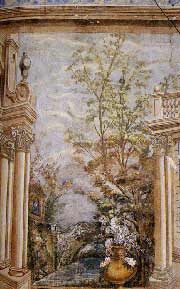
He gained a position at Torricella the home of Giacomo Boncompagni, Duke of Sora, Pope Gregory XIII's (Ugo Boncompagni) illegitimate son. (Gregory raised his two nephew's to the position of Cardinal and had plans to eventually make his son King of Ireland. Unfortunately for Giacomo, these plans fell through.) There he received a stipend of 300 scudi per year. Giacomo Boncompagni was one of the great patrons of chess during the Renaissance. Polerio never published a book, but he wrote many manuscripts between 1572 and 1584 which he collated and dedicated to the Duke of Sora called the Manuscrito Buoncompagno and another group called Trattato degli scacchi dell'Abruzzese in 1594. These manuscripts contain 148 games, 38 problems and a 36 versed poem by Rotilio Gracco. It includes games Leonardo di Bono, Paolo Boi, ,Ruy Lopez, Alfonso Cerón, Giovanni Doménico d'Arminio, Santa Maria, il Sadoleto, Busnardo and the count of Ávalos. He also demostrates such opening as the Muzio, the Sicilian, the Scandinavian, the Berlin Defense, the 2 Knight and 4 Knight defenses and the Fried Liver Attack. Polerio was considered one of the strongest players at the end of the 16th century. Around 1606 he was beaten in Rome by Dr. Geronimo Cascio (born in 1571 in Piazza Armerina in Enna, Sicily -supposedly demostrated the Muzio variation to Senor Muzio who showed it to Salvio. Cascio previously lost to Salvio and in losing was forced to pay the debts of his unsavory backers who bet on him to win. After defeating Polerio, though, he was given a position in the palace of Jacopo Boncompagni at 250 scudi/year. In 1620, he beat il Marano, a leading player of the day). Polerio died in 1608.
Alessandro Salvio was born in Naples around 1570. He was from a well-to-do family and was well educated, achieving the title of doctor. He studied chess under Michele di Mauro and Scipione Genoino. He beat Paolo Boi in 1598 and Geronimo Cascio in 1606 Salvio published Il trattato dell'inventione et arte liberale del gioco di scacchi in 1604, La Scaccheide in 1612 and il Puttino, altramente detto il Cavaliere errante in 1634. Dr. Salvio died around 1640.
Pietro Carrera, born in Militello, Sicily July 12, 1573, was a theorist and writer more so than a player. He wrote II Gioco de gli Scacchi in 1617. He and Salvio were in a professional feud, writing criticisms of each other's contributions.
Carrera developed a game using an 8 x 10 squared board with an extra two men, one called champions who would possess the combined abilities of the rook and the knight and the other called centaurs who would possess the combined abilities of the bishop and the knight.
The rules for this game can be found h e r e . You can actually play a game of Carrera Chess h e r e .
Pierto Carrera died Sept. 18, 1647 in Messina, Italy.
Gioachino Greco, also known as Il Calabrese, was born around 1600 in Celico, which near Cosenza in Calabria. Calabria had already produced such players as Leonardo di Bono and Michele di Mauro. From his writing it's apparent the he wasn't educated and likely came from a lower class family. Already in 1619, Greco started keeping a notebook of tactics and particularly clever games and he took up the custom of giving copies of his manuscripts to his wealthy patrons. In Rome Monsignor Corsino della casa Minutoli Tegrini, Cardinal Savelli and Monsignor Francisco Buoncompagni all received copies (of which there are extant copies, dated 1620 in the Corsiniana library in Rome, under the title, Trattato del nobilissimo gioco de scacchi).
Despite his popularity in Rome, in 1621 Greco took off to test himself against the rest of Europe leaving this paper trail as he went. In 1621 he left a fine copy of his manuscripts with Duke Enrico of Lorraine in Nancy. He traveled to Paris where he played Arnauld (Isaac) de Corbeville, Enrico di Savoia (the Marquis of St. Sorlin and the Duke of Nemours and Geneva) and others. He had apparently been quite successful because in traveling from Paris to England he was waylaid by robbers who divested him of 5,000 scudi, a princely sum. Finally making it to London, he beat all the best players. Sir Francis Godolphin and Nicholas Mountstephen were given copies of his manuscripts. While in London, Greco developed an idea to record entire games rather than positions for study and inclusion in his manuscripts. He returned to Paris in 1624 where he rewrote his manuscript collection to reflect his new ideas. He then went to Spain and played at the court of Philip IV. There he beat his mentor and the strongest player of the time (other than himself), don Mariano Morano. He finally returned to Italy where he was enticed to traveling to the New Indies, the Americas, by a Spanish nobleman. He seemingly contracted some disease there and died around 1630 (possibly 1634) at the young age of 30 (34). He generously left all the money he earned at chess to the Jesuits.
Gioachino Greco stood head and shoulders above his contemporaries, a feat seldom duplicated. David Hooper, in The Oxford Companion to Chess, states that Greco probably made up the games in his manuscripts. The question of whether he actually played the games or invented them is rather moot since if he invented them, he was perfectly capable of playing them.
written by Harold James Ruthven Murray in his book, A History of Chess, referring to the 1656
publication by Francis Beale of Greco's work under the title, The royall Game of Chesse-play
